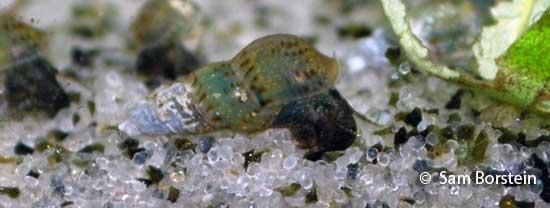Melanoides tuberculatus tuburculatus
Muller, 1774
Malaysian Livebearing Snail, Malaysian Trumpet Snail

Above: A Malaysian Trumpet Snail. Photo by Sam Borstein.
Etymology:
Genus- Melanoides= melas= black (Greek), oides= similar (Greek).
Species- tuberculatus= tubercules (Greek).
subspecies- tuberculatus= tubercules (Greek).
Intro:
The Malaysian Livebearing Snail is usually considered a pest among hobbyists. These tiny snails, first typed by Muller in 1774, have they ability to take over a tank, and once you have them, it's hard to get rid of them.
There are a few ways to get rid of these snails:
1. Take a net through the sand and net them out.
2. Beer Bottle Method: bait a beer bottle with fish food and leave it in overnight. The snails will crawl in and you can trap them this way.
3. Find something that will eat them, like the Assassin Snail or various loach species.
There is another subspecies, Melanoides tuberculatus formosensis.
Distribution:
Malaysian trumpet Snails can be found in fresh and brackish waters of subtropical Asia and Africa.
Size, Maturity, and Sexual Dimorphism:
Size: 1 inchMaturity: .5 inches
Care:
Malaysian Trumpet Snails are easy to care for and really require no care. They burry themselves in the sand and are tolerant of almost any water parameters.
Diet:
This snail eats just about anything, including algae and dead organisms.
Breeding:
Malaysian Trumpet Snails breed by themselves and require little. If you see one in your tank, there are many more to come. They give live birth to up to 70 babies.
Conclusion:
Malaysian Livebearing Snails are a pest in my opinion and are not welcome in my tanks, although they constantly find their way in. Some people like them because they aerate the sand by digging and eat uneaten food, but in my experience they easily over run tanks to the point of being a nuisance.
